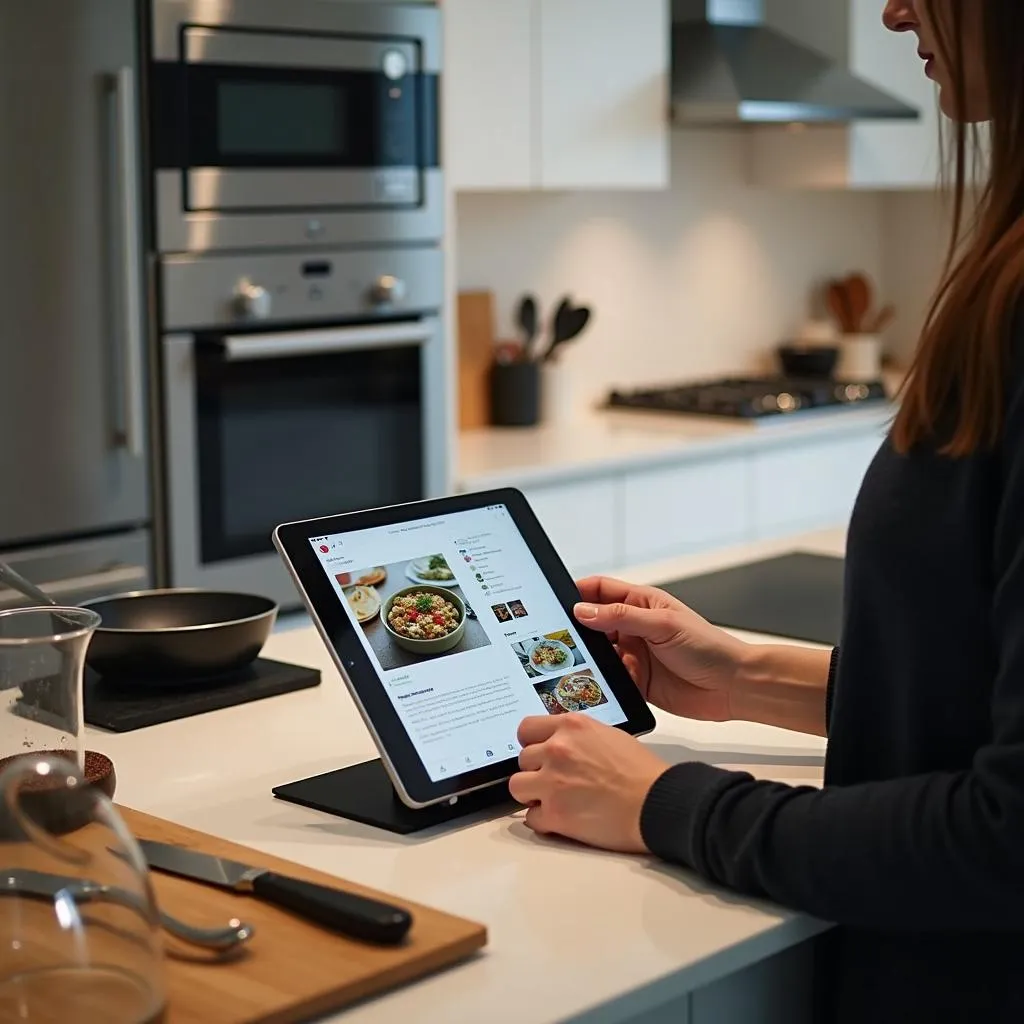The IELTS Speaking test often includes questions about food and cooking, making “describe a favorite dish you like to cook” a popular topic. This theme has appeared frequently in past exams and is likely to remain relevant in future tests. Let’s explore how to effectively answer this question and impress the examiner with your culinary knowledge and English language skills.
Nội dung bài viết
Part 1: Introduction and Interview
In the first part of the Speaking test, the examiner may ask general questions about cooking and food preferences. Here are some common questions you might encounter:
- Do you enjoy cooking?
- What’s your favorite dish to prepare?
- How often do you cook at home?
- Where did you learn to cook?
Let’s look at a sample answer for the question “What’s your favorite dish to prepare?”:
Sample Answer (Band 7-8):
“My favorite dish to prepare is definitely homemade pizza. I love the whole process, from kneading the dough to choosing the toppings. It’s a dish that allows for so much creativity and personalization. Plus, the aroma that fills the kitchen when it’s baking is absolutely irresistible.”
Describe a holiday celebration you enjoy often involves special foods and meals, which can tie in nicely with discussing favorite dishes to cook.
Part 2: Long Turn
In this section, you’ll be given a cue card with a topic and some bullet points to guide your response. Here’s a sample cue card related to our theme:
Describe a favorite dish you like to cook
You should say:
- What the dish is
- How you learned to cook it
- What ingredients are needed
- And explain why you enjoy cooking this dish IELTS Speaking cue card about favorite dish to cook
IELTS Speaking cue card about favorite dish to cook
Sample Answer (Band 6-7):
“The dish I really enjoy cooking is spaghetti carbonara. I learned to make it from my Italian roommate when I was studying abroad in Rome. It’s a simple dish, but it requires some skill to get it just right.
The main ingredients are spaghetti, eggs, Pecorino Romano cheese, pancetta or bacon, and black pepper. You need to cook the pasta al dente, fry the pancetta until crispy, and then mix everything together quickly so the eggs create a creamy sauce without scrambling.
I love cooking this dish because it reminds me of my time in Italy, and it’s always a hit with my friends. It’s also quite quick to make, which is perfect for busy evenings.”
Sample Answer (Band 8-9):
“I’d like to talk about my absolute favorite dish to cook: authentic Thai green curry. I developed a passion for this aromatic delicacy during a culinary adventure in Thailand, where I had the privilege of learning from a local chef in a small village outside Chiang Mai.
The key components of this dish include fragrant herbs like lemongrass, kaffir lime leaves, and Thai basil, along with fiery green chilies, succulent chicken or tofu, and creamy coconut milk. The piece de resistance is the homemade curry paste, which I painstakingly prepare using a traditional mortar and pestle.
What captivates me about cooking this dish is the sensory experience it provides. The vibrant colors of the fresh ingredients, the intoxicating aroma that fills the kitchen, and the gradual layering of flavors as the curry simmers are all incredibly satisfying. Moreover, the dish allows for creative variations – I often experiment with different vegetables or proteins to keep things interesting.
Perhaps most importantly, this curry serves as a culinary bridge to my experiences in Thailand. Every time I prepare it, I’m transported back to that small, bustling kitchen where I first learned the secrets of Thai cuisine. It’s not just about the food; it’s about preserving memories and sharing a piece of culture with friends and family.”
Follow-up Questions:
- How has your cooking of this dish improved over time?
- Would you consider teaching others how to make this dish?
Sample Answer (Band 8-9):
“Over the years, I’ve honed my technique significantly. I’ve learned to balance the flavors more precisely, adjusting the heat and aromatics to create a more nuanced taste. As for teaching others, I’d be thrilled to share this culinary knowledge. In fact, I’ve been considering hosting cooking workshops to introduce more people to the joys of authentic Thai cuisine.”
Part 3: Two-way Discussion
In this section, the examiner will ask more abstract questions related to the topic. Here are some potential questions and sample answers:
Q: How has technology changed the way people cook at home?
Sample Answer (Band 6-7):
“Technology has made cooking at home much easier. We can find recipes online quickly, and kitchen gadgets like food processors save a lot of time. Also, many people now share their cooking on social media, which inspires others to try new dishes.”
Sample Answer (Band 8-9):
“Technology has revolutionized home cooking in myriad ways. The proliferation of cooking apps and online recipe databases has democratized access to global cuisines, allowing home cooks to effortlessly experiment with dishes from around the world. Smart kitchen appliances, such as precision cookers for sous-vide or app-controlled ovens, have elevated the precision and consistency of home cooking to near-professional levels.
Moreover, the rise of food-centric social media has created a culture of culinary sharing and inspiration. Platforms like Instagram and TikTok have turned home cooking into a form of creative expression and social currency, encouraging people to be more adventurous and aesthetically mindful in their culinary endeavors.
However, this technological integration also raises questions about the preservation of traditional cooking methods and the potential loss of hands-on cooking skills. It’s a double-edged sword that while making cooking more accessible, may also be changing our relationship with food preparation in fundamental ways.”
 Technology's impact on home cooking
Technology's impact on home cooking
Describe a dish you like to cook for guests can be an excellent way to showcase your culinary skills and hospitality, much like discussing your favorite dish to cook.
Q: Do you think traditional cooking methods are being lost due to modern lifestyles?
Sample Answer (Band 8-9):
“There’s certainly a valid concern that traditional cooking methods are at risk of being eclipsed by modern conveniences. The fast-paced nature of contemporary life often leads people to opt for quick, pre-prepared meals or rely heavily on modern appliances, potentially sidelining time-honored cooking techniques.
However, I’d argue that we’re also witnessing a countertrend. There’s a growing movement towards culinary heritage preservation, with many people actively seeking out traditional recipes and methods. This resurgence of interest is evident in the popularity of artisanal food markets, cooking shows featuring traditional techniques, and the rise of slow food movements.
Furthermore, the globalization of cuisine has paradoxically led to a heightened appreciation for authentic, traditional cooking methods. As people become more culinarily adventurous, there’s often a desire to experience dishes made in their most authentic form, which often involves traditional cooking methods.
Ultimately, while some traditional methods may be practiced less frequently in everyday cooking, they’re being preserved and celebrated in other ways. The challenge lies in striking a balance between embracing modern conveniences and maintaining our rich culinary heritage.”
Key Vocabulary and Phrases for High Scores
To elevate your responses and aim for higher band scores, incorporate these sophisticated words and phrases:
-
Culinary adventure /ˈkʌlɪnəri ədˈventʃər/ – An exciting experience related to cooking or food
Example: “My trip to Italy was a true culinary adventure, introducing me to authentic pasta-making techniques.” -
Aromatic /ˌærəˈmætɪk/ – Having a pleasant and distinctive smell
Example: “The aromatic spices in the curry filled the kitchen with an irresistible fragrance.” -
To hone (one’s skills) /həʊn/ – To refine or perfect over time
Example: “Over years of practice, I’ve honed my baking skills to create the perfect sourdough bread.” -
Gastronomic /ˌɡæstrəˈnɒmɪk/ – Relating to the art of cooking and eating good food
Example: “The annual food festival is a gastronomic delight, showcasing cuisines from around the world.” -
To savor /ˈseɪvər/ – To enjoy or appreciate something completely, especially by dwelling on it
Example: “I love to savor every bite of a well-prepared meal, appreciating the complex flavors and textures.”
Describe a memorable time at a restaurant can provide inspiration for discussing flavors, cooking techniques, and dining experiences that relate to your favorite dish to cook.
Examiner’s Advice
To achieve a high score in the IELTS Speaking test when discussing your favorite dish to cook:
- Use a wide range of vocabulary related to cooking, ingredients, and flavors.
- Incorporate personal anecdotes and experiences to make your answers more engaging and authentic.
- Practice describing the cooking process in detail, using sequencing words and specific cooking verbs.
- Be prepared to discuss broader topics related to food, such as cultural significance, health aspects, or environmental impacts of cooking.
- Show your ability to express opinions and analyze trends in cooking and eating habits.
Remember, the key to success in the IELTS Speaking test is not just about what you say, but how you say it. Aim for fluency, coherence, and natural expression while showcasing your language skills and knowledge about the topic.
Describe a traditional meal in your culture can be an excellent way to demonstrate cultural knowledge alongside your cooking expertise when discussing favorite dishes.


